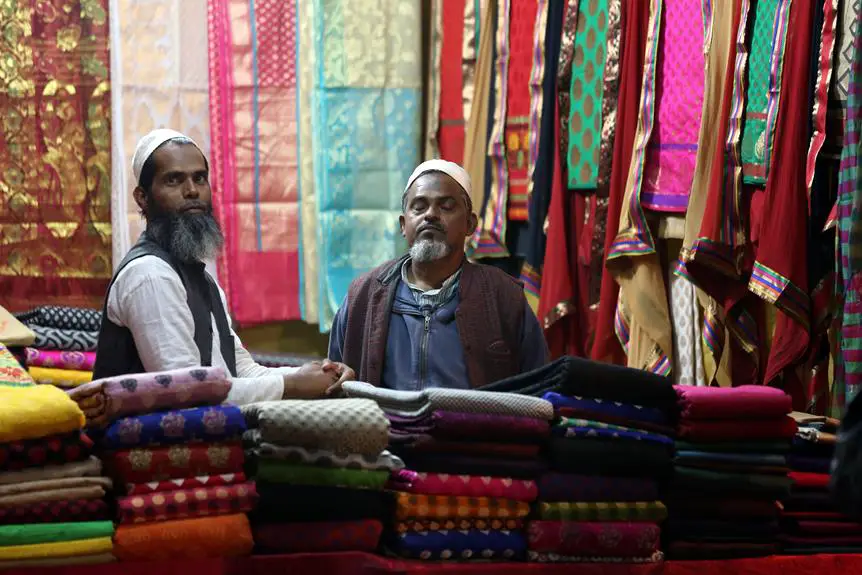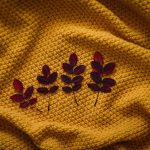You may not realize that weaving fabrics involves more than just the basic over-under motion. Mastering the art of weaving requires attention to detail and technique.
To help you achieve mastery, here are 5 essential tips for weaving fabrics. From choosing the right yarn to understanding different weaving patterns, proper loom set-up, tension and beat control, and finishing techniques, these tips will elevate your weaving skills and help you create beautiful, high-quality fabrics.
Whether you're a beginner looking to improve or an experienced weaver seeking to refine your craft, these tips will guide you toward weaving success.
Key Takeaways
- Consider the weight and fiber content of the yarn for your weaving project.
- Choose weaving patterns that create the desired textures and designs in the fabric.
- Ensure proper loom set-up and maintenance for optimal performance.
- Master tension and beat control for even weaving and high-quality fabrics.
Choosing the Right Yarn
Choose yarn with the appropriate weight and fiber content for your weaving project. The yarn weight will determine the thickness of your fabric, so consider the drape and texture you desire. For a delicate, airy fabric, opt for a lace-weight yarn, while a thicker yarn such as worsted weight will produce a more substantial fabric. Additionally, the fiber content of the yarn impacts the look and feel of the woven material. Wool yarn is resilient and elastic, making it ideal for items that need to retain their shape, while cotton yarn offers a crisp, matte finish.
When selecting colors for your weaving project, consider the overall aesthetic you wish to achieve. Are you aiming for a harmonious blend of colors or a bold, contrasting statement piece? Take into account how the colors will interact in the woven fabric. Variegated yarns can produce captivating visual effects, while solid colors lend themselves well to intricate patterns and designs. Keep in mind that the color of the yarn can significantly influence the mood and impact of the final woven piece.
Understanding Different Weaving Patterns
When you understand the different weaving patterns, you can create a wide variety of textures and designs in your fabric. Weaving patterns are determined by the way the warp and weft threads interlace with each other. Two common weaving patterns are twill and plain weave. In a plain weave, the weft thread goes over one warp thread and under the next, creating a simple, strong, and versatile fabric. On the other hand, twill weave produces a diagonal pattern by interlacing the weft thread over one or more warp threads and then under two or more warp threads.
| Weaving Pattern | Description |
|---|---|
| Plain Weave | Simple over-one, under-one interlacing, creating a strong and versatile fabric. |
| Twill Weave | Diagonal pattern created by over-one, under-two (or more) interlacing, producing a textured fabric. |
| Satin Weave | Smooth and lustrous fabric achieved by floating weft yarns over multiple warp yarns. |
Understanding these patterns allows you to manipulate the weave structure to achieve various textures, designs, and functionalities in your woven fabrics. Mastery of these fundamental weaving patterns provides a solid foundation for creating unique and intricate woven textiles.
Proper Loom Set-Up
To ensure a successful weaving process, set up your loom properly to create the foundation for your fabric. Loom maintenance is crucial for optimal performance. Regularly clean your loom to remove dust and debris that can affect its function. Check for any loose or damaged parts, and make necessary repairs to ensure smooth operation. Additionally, oiling the moving parts of the loom can prevent friction and prolong its lifespan.
Warp preparation is another essential aspect of proper loom set-up. Carefully measure and align the warp threads to ensure even tension across the entire width of the fabric. This will prevent uneven weaving and produce a high-quality finished product. Properly securing the warp threads to the loom and ensuring they're evenly spaced is vital for achieving consistent and professional results.
Tension and Beat Control
Ensuring even tension and controlling the beat are crucial for achieving consistent and professional results in your weaving projects. Proper tension adjustment and beat consistency are essential elements that contribute to the overall quality of your woven fabric. Here are some essential tips to help you master tension and beat control:
- Tension Adjustment: Regularly check and adjust the tension of your warp and weft threads to maintain an even and balanced tension throughout the weaving process. Uneven tension can lead to irregularities in the woven fabric, affecting its overall appearance and strength.
- Beat Consistency: Pay close attention to the beat or the force applied when pushing each weft thread into place. Consistent beating ensures uniform density and stability across the fabric. Practice maintaining an even beat to avoid variations in fabric texture and appearance.
- Monitoring Tools: Utilize tools such as tension gauges and beat sticks to measure and maintain the desired tension and beat throughout the weaving process. These tools provide precise control and help achieve uniform results.
- Technique Refinement: Continuously refine your weaving technique to achieve optimal tension adjustment and beat consistency. Practice and experience will enhance your ability to effectively control these critical elements in weaving.
Mastering tension and beat control is fundamental to producing high-quality woven fabrics, and diligent attention to these aspects will elevate the craftsmanship of your weaving projects.
Finishing Techniques
You can enhance the quality and appearance of your woven fabric by implementing effective finishing techniques.
Hemstitching is a classic method that adds a delicate, decorative touch to the edges of your fabric. It involves creating a series of small, evenly spaced holes along the fabric's edge and then stitching them together to form a beautiful, intricate pattern. This technique not only prevents the fabric from unraveling but also adds an elegant finish.
Fringe finishing is another popular way to add a stylish edge treatment to your woven fabric. By leaving the weft threads at the edges of the fabric longer and then securing them in place, you can create a fringe that adds texture and visual interest to your piece.
Additionally, you can incorporate decorative borders into your fabric by weaving in contrasting or complementary yarns to create intricate patterns or adding embellishments such as beads or tassels.
Frequently Asked Questions
Can I Use Unconventional Materials for Weaving, Such as Strips of Old T-Shirts or Plastic Bags?
You can upcycle materials like old t-shirts or plastic bags for weaving. Get creative with your weaving techniques and experiment with unconventional materials. It's a great way to add unique textures and patterns to your fabric.
How Do I Prevent My Fabric From Becoming Too Stiff or Too Loose During the Weaving Process?
To prevent shrinkage and maintain tension while weaving, always use consistent force when pulling the weft. Be mindful of the material's elasticity and adjust the tension accordingly. Avoid pulling too tightly or loosely to ensure a balanced fabric.
Are There Any Specific Techniques for Weaving Intricate Designs or Patterns Into My Fabric?
To create intricate designs, advanced weaving techniques like pick-up weaving or tapestry weaving can be used. These methods allow for precise pattern creation by manipulating individual warp and weft threads to achieve stunning, detailed designs.
What Are Some Common Mistakes to Avoid When Setting up My Loom for Weaving?
When setting up your loom for weaving, common mistakes to avoid include using the wrong weaving materials, improper loom setup, and not adjusting for fabric stiffness. Take care to avoid these errors for successful weaving.
How Can I Incorporate Different Textures and Thicknesses of Yarn Into My Woven Fabric for Added Interest?
To add interest to your woven fabric, experiment with different textures and thicknesses of yarn. Incorporating color contrast and embellishments can create visual and tactile appeal. Be creative and explore various combinations for unique results.







